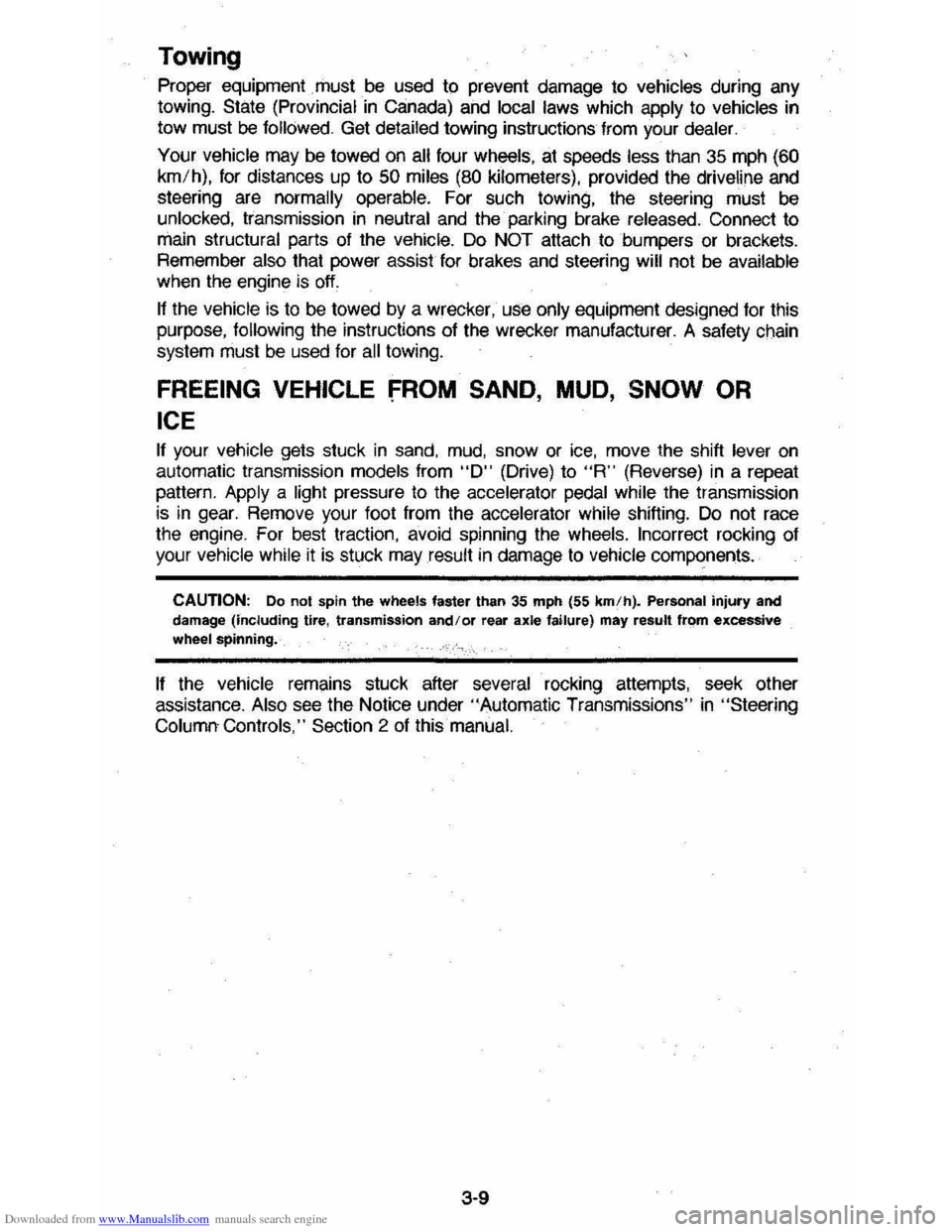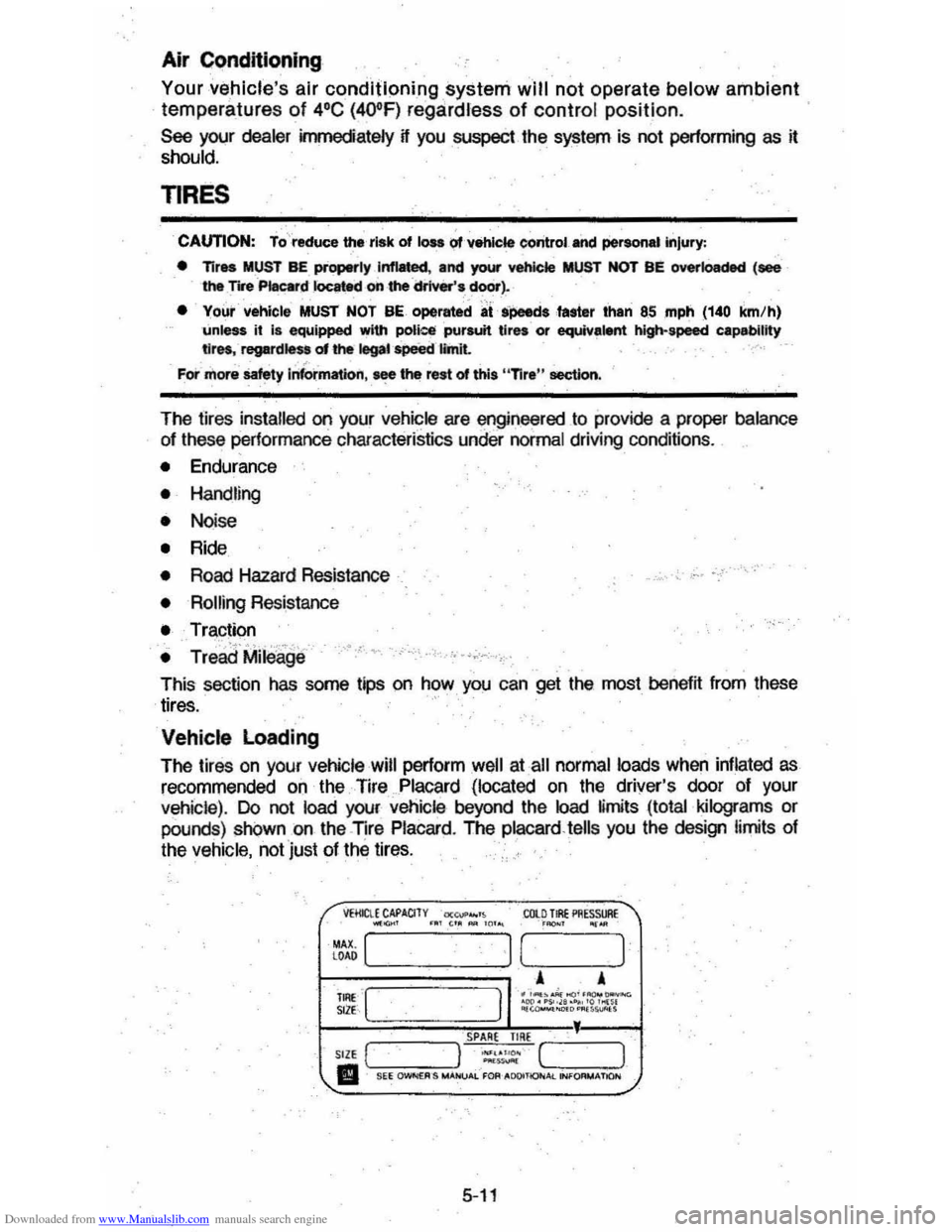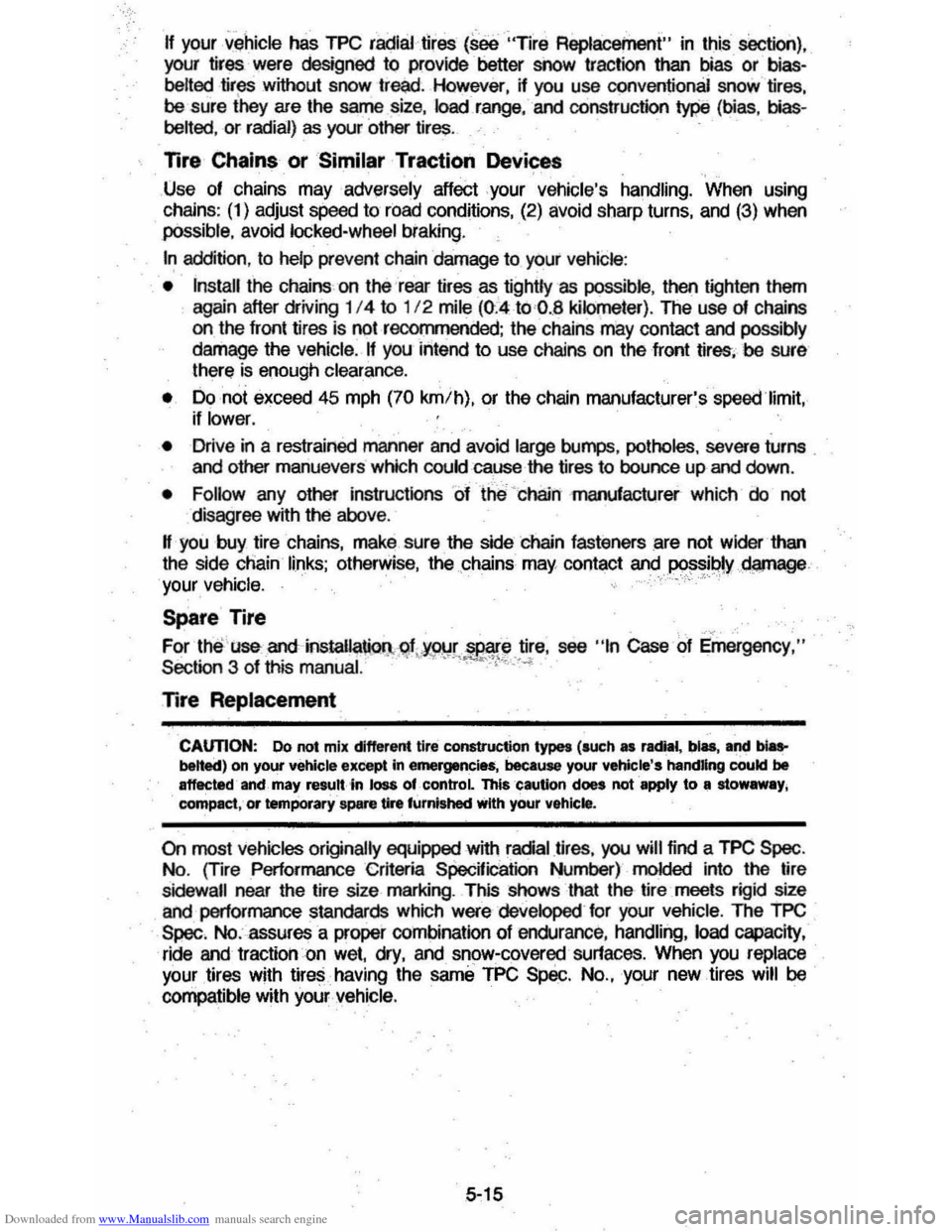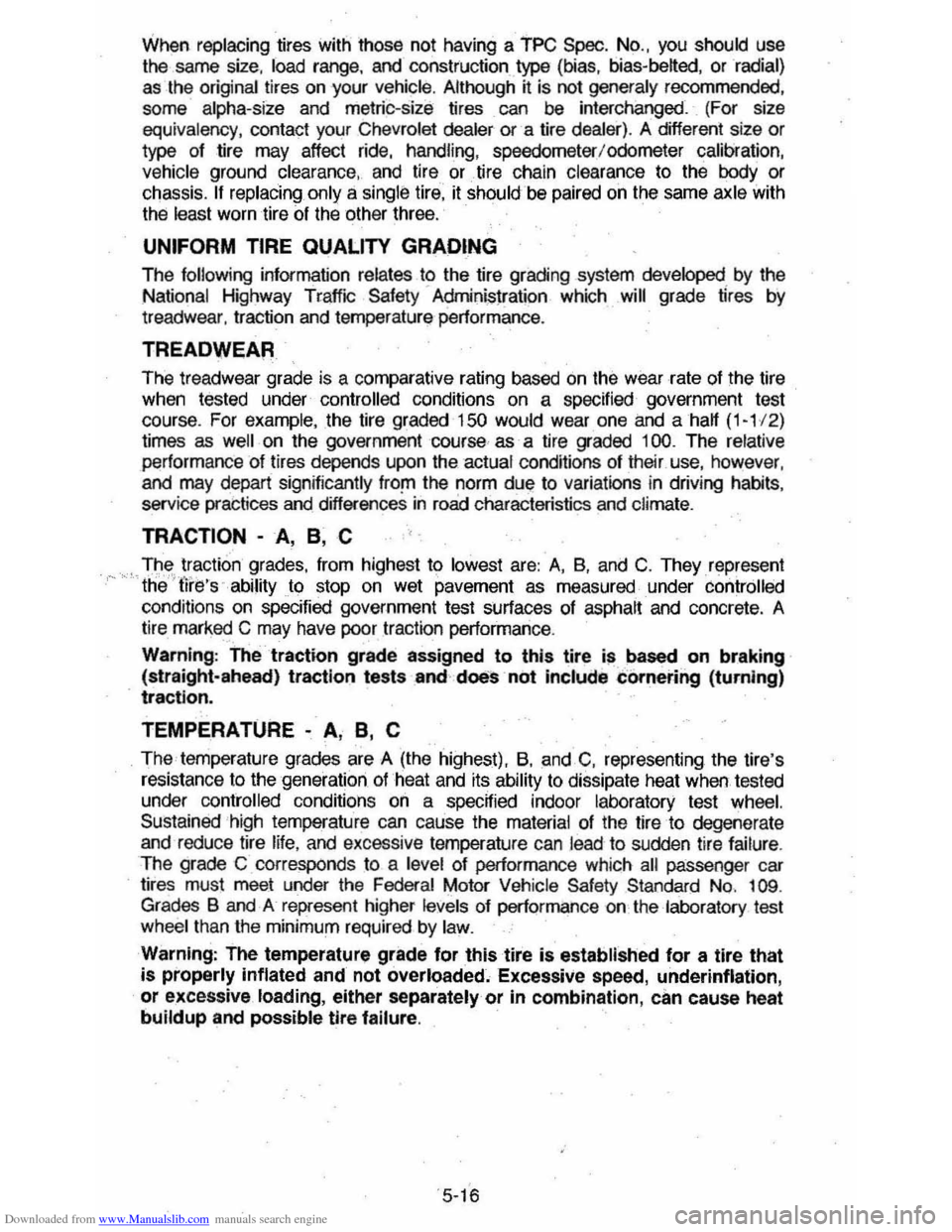traction control CHEVROLET MONTE CARLO 1981 4.G Owners Manual
[x] Cancel search | Manufacturer: CHEVROLET, Model Year: 1981, Model line: MONTE CARLO, Model: CHEVROLET MONTE CARLO 1981 4.GPages: 104, PDF Size: 23.92 MB
Page 49 of 104

Downloaded from www.Manualslib.com manuals search engine OTHER CONTROLS AND FEATURES
LIMITED-SLIP REAR AXLE
On vehicles that have it. the optional limited-slip rear axle can give added
traction on snow, ice, mud, sand, gravel, etc. Normally , the limited-slip axle
unit works like a standard axle. However, when either drive wheel meets a
slippery enough surface, and the opposite wheel is on a surface with greater traction, the ,limited-slip 'unit can continue to give driving force tathe wheel
having the greater traction,instead 01 merely spinning the wheel that has the
least traction .
Whether your
vehicle has an optional limited-slip rear axle or a standard axle, take care when speeding up or, whera shifting into a lower gear or lower gear
range , when either or both rear wheels are traveling over a slippery surface .
Sudden acceleration or engine braking action (due to shifting to a lower gear)
could cause one or both drive wheels to spinorskid and the rear 01 the vehicle to slide sideways on the crowned, ·surface of a road or in a turn. Normal skid correction and cautious driving are called for at these times.
COURTJ:SY LIGHT DELAY SYSTEM
If your vehicle is equipped with this optional feature, whenever the door is opened, then closed, on entry or exit, the dome and courtesy lights stay on for thirty seconds for convenience of driver and passengers. This presumes the
ignition is in the off position . When the ignition key is turned on. the lights will
go off. When the ignition key is turned to off, the dome and courtesy lights go
",'" of>.lor. ~.R~riod 01 fifteen seconds.
SUNROOF
The optional Sunroof is a slid ing metal panel, electrically operated. controlled
by a switch on the front center area ,Qf theroof. The ignition must be in "Run" to move the panel. " .
To' open. press the control switch rearward. To close. press it forward. The
Sunroof can
be lett partly open by releasing the control switch while you are
opening or closing the panel.
The Sunrool can be closed manually il your car has an electrical power lailure.
To do this , remoVe the small round plug in the rool (near the control switch) by pulling the plug downward with your lingers . Then insert the hex end 01 the
crank handle (supplied in your glove box) into the drive gear and turn it
clockwise to close the rool panel, and counterclockwise to open it. Remove the
crank handle and replace the plug . (See illustration.)
2-30
Page 61 of 104

Downloaded from www.Manualslib.com manuals search engine Towing
Proper equipment .must be used to prevent damage to vehicles during any
towing. State (Provincial in Canada) and local laws which apply to vehicles in
tow must be
followed. Get detailed towing instructions from your dealer.
Your vehicle
may be towed on all four wheels, at speeds less than 35 mph (60
km/h), for distances up to 50 miles (80 kilometers), provided the driveline and
steering are normally operable. For such towing, the steering must be unlocked, transmission in neutral and the· parking brake released. Connect to
main structural parts of the vehicle. Do NOT attach to bumpers or brackets.
Remember also that power assist for brakes and steering will not be available when the engine is off.
If the vehicle is to be towed by a wrecker, use only equipment designed for this purpose, following the instructions of the wrecker manufacturer. A safety Chain
system must be used for all towing.
FREEING VEHICLE FROM SAND, MUD, SNOW OR
ICE
If your vehicle gets stuck in sand, mud, snow or ice, move the shift lever on automatic transmission models from "0" (Drive) to "R" (Reverse) in a repeat
pattern.
Apply a light pressure to the accelerator pedal while the transmission is in gear. Remove your foot from the accelerator while shifting. Do not race
the engine. For best traction, avoid spinning the wheels. Incorrect rocking of your vehicle while it is stuck may result in damage to vehicle components.
CAUTION: Do not spin the wheels faster than 35 mph (55 km/h). Personal injury and
damage (inCluding tire, transmission and/or rear axle failure) may result from excessive
wheel spinning.
If the vehicle remains stuck after several rocking attempts, seek other
assistance. Also see the Notice under '(Automatic Transmissions" in "Steering
Column-Controls," Section 2 of this manual.
3-9
Page 79 of 104

Downloaded from www.Manualslib.com manuals search engine Air Conditioning
Your vehicle's air conditioning system will not operate below ambient
temperatures of 4'C (40"F) regardless of control position. .
See your
dealer immediately H you suspect the system is not performing as it
should.
TIRES
CAUTION: T~\'reduce the 'risk of lose ~VehiCIe control and Person.1 injury:
• TTres MUST BE prOperly Inflated, .nd your vehicle MUST NOT BE overkMtded (see 1M r.e PtacM'.d _1Oc_.c:t on the driver's door).
• Voui" vehicle MUST NOT BE operated cti, lpeedsfaster than 85 mph (140 ~m/h) unless it Is equipped with poIi~ pursuit tires or equivalent high-speed capability ti,es.-regardhtss 01 the ~ speed lmtt.
For more Safety InfOrmation. ~ the rest or this " TIre" section.
The tires installed on your vehicle are engineered to provide a proper balance
of these performance characteristics under normal driving conditions.
• Endurance
• Handling
• Noise
• Ride
• Road Hazard Resistance
• Rolling Resi.stance
• Traction
• Tread Mile'age"' •... .... <.
This section has some tips on how you can get the most benem from these tires. '
Vehicle Loading
The tires on your vehicle will perform well at all normal loads when inflated as
recommended on the . Tire Placard (located on the driver's door of your vehicle) . Do not load your vehicle beyond the load Umits (total kilograms or
pounds) shown
on the·TIre Placard . The placard. tells you the design limits of
the vehicle, not
Just of the tires.
VEt«:lf CAP.l.CIl" DCGuI' ... " ,COLO Tff\E ffiESSURE ... _, ,., " •... 10'" ,_, "' ...
SPAR{ HR£
",,! " 1-::.:::(' 1 • SEE O~ S ~ANu ... i. FOR "'OI)IJ lQtjA,l INf-QAMATioN
5·11
Page 82 of 104

Downloaded from www.Manualslib.com manuals search engine CAUTION: Before installing wheels, remove any· buildup of corrosion on the wheel mounting surface .and brake drum or brakedilic mounting surface, by scraping and wire
brushing. Installing wheels without good metaHo-metal contact at the mounting surfaces
can cause wheel nuts to loosen, which can . later allow a wheel to come off while the vehicle is moving, possibly causing loss of control. (Also see the "Wheel Nut Torque"
Caution in "In Case of Emergency," Section 3 of this manual, on page 3·7.)
-'-:'O'rt-
P<1 ~ELRo:t 4 WHEHROTATION PREFERRED ·OPTIONAl
DO NOT INCLUDE "TEMPORARY USE ONLY· SPARE TIRE IN ROTATION
• THE OPTIONAL 'X' ROTATION PATTERN FOR RADIALS IS ACCEPTABLE WHEN REQUIRED FOR MORE UNIFORM TIRE WEAR
Alignment and Balance
Proper wheel alignment· improves tire tread. mileage. Your vehicle's suspension
parts should be inspected often and aligned when needed. (See the Maintenance Schedule Folder for more information.) Ball joints have built-in wear indicators and some movement in the joints is normal. Improper
alignrnentwill not cause the vehicle to vibrate. However, improper ~Iignment can cause:
• the tires to roll at an angle, which will result in faster tire wear;
• your tires to wear unevenly;
• your vehicle to "pull" to the left or right. .
Proper tire balancing provides the best riding comfort and helps reduce tire
tread· wear. Out-of-balance tires can cause annoying vibration and uneven tire wear such as cupping and flat spots.
Traction
Driving, cornering, and braking traction are reduced when water, snow, ice,
gravel, or other material is on the road. Adjust driving practices and vehicle speed to road conditions.
When driving on wet or slushy roads,a wedge of water can build up between
the tire and road. This is known as hydroplaning, and may cause partial or complete loss of traction, vehicle control, and stopping ability.
To reduce
the chance of traction loss, follow these tips:
1. Slowdown during rainstorms or when roads are slushy.
2. Slow down if the road has standing water or puddles.
3. Replace the tires when the tread wear indicators are showing.
4. Keep the tires properly inflated.
5-14
Page 83 of 104

Downloaded from www.Manualslib.com manuals search engine If yqurv~hicle has TPC radial tires (see ;'Tire Aeplaceinent" in this section),
your tires were designed to provide better snow traction than bias or
bias
belled tir~ wijhout snow treed. However, ij you use conventional snow tires,
be sure they are the same size, ioadrange , and construction type (bias, biasbelted, or radial) as your other tires .
Tire Chains or Similar Traction Devices
Use of chains may adversely affect your vehicle's handling. When using
chains:
(1) adjust speed to road conditions, (2) avoid sharp turns, and (3) when possible, avoid locked-wheel biaking.
I~ addition , to help prevent chain damage to your vehicle:
• Inslall the chains on the 'rear tires as tightly as possible , then tighten them
again af1er driving 1 /4 to 1 /2 mile «}:4t6·(} .. 8 kilometer) . The use 01 chains
on the front tires is not recommended; the chains may contact
and possibly
damage the vehicle :
If you intend to use chains on the front tires; be sure ther~ is enough clearance.
• Danai exceed 45 mph (70 krn/h), or the chain manufacturer's speed' limit, if lower.
•
Drive in a restrained manner and avoid large bumps, potholes, severe turns .
and other manuevers wliich could cause the tires to bounce up and down.
• Follow any other instructions 'of il1li -chain manufacturer which do not
disagree with the above.
n you buy tire chains, make sure the side chain fasteners are not wider than
the side chain
links; otherwise, the .chains may contact and possill!y.d~age. your vehicle. • .
Spare Tire
For the·useandinslalla~qf"I'WL.~~._tire, see "In Case of Emergency," Section 3 of this manual. ..,· •.. 4.
Tire Replacement
CAlITION: Do not mix different tire construction types (such as radial, bias, artd bl .. belted) on your vehicle except In emergenci •• , bee.UN your vehicle's handling could be aftKtedandmay resun"in loea o':control. ThiscauUon does not apply to a stowaway ; compact, or temporary spare Ore furnished with your vehicle.
On most vehicles originally equipped wijh radial .tires, you will find a TPC Spec . No. (Tire Performance Crijeria Specijication Number) molded into the tire
sidewall near the tire size marking . This shows that the tire meets rigid size
and performance standards which
weredevelopelffor your vehicle . The TPC
Spec. No: assures a proper combination of endurance , handling, load capacity,
ride and traction on wet, dry, and snow-covered surfaces. When you replace
your tires with tires having the
same TPC Sp~. No., your new tires will be
cOrTlpatible with your vehicle .
5-15
Page 84 of 104

Downloaded from www.Manualslib.com manuals search engine When replacing tires with those not having a TPC Spec. No., you should use
the same size,
load range, and constructiontype (bias, bias-bened, or radial)
as the original tires on your
vehicle . Although ~ is not generaly recommended ,
some alpha-size and metric-size tires can be interchanged. (For size
equivalency, contact your Chevrolet
dealer or a tire dealer) . A different size or
type of tire may affect ride,
handling, speedometer /odometer calibration,
vehicle ground clearance , and tire or tire chain clearance to the body or
chassis .
II replacing only a single tire, it should be paired on the same axle with the least worn tire of the other three.
UNIFORM TIRE QUALITY GRADING
The following information relates to the tire grading system developed by the
National Highway Traffic Safety' Adminlslration which will grade tires by
treadwear, traction and temperature performance.
TREADWEAR
The treadwear grade is a comparative rating based on the wear rate of the tire
when tested under
controlled conditions on a specified government test
course . For example, the tire graded 150 would wear one and a haij (1-1/2)
times as well on the government course as a tire graded 100. The relative
performance of tires depends upon the. actual conditions of their _ use , however ,
and may depart significanlly from the norm due to variations in driving habits , service practices and. differences in road characteristics and climate.
TRACTION -A, B,C
. T~~tr~ction grades, from highest to lowest are: A, B, and C. They represent
the ' fiie'sability to stop on wet pavement as measured under controlled
conditions on specified government test surfaces of asphalt and concrete . A
tire marked C may have poor traction performance .
Warning: Thetr.ction grade assigned to this tire is based on braking (straight-ahead) traction tests and· doellnot include cornerillg (turning) tractlon.
TEMPERATURE -A, B, C
The ·temperature grades are A (the highest), B, andC, representing the tire's
resistance to the generation of heat and its ability to dissipate heat when tested under controlled conditio 'ns on a specified indoor laboratory test wheel.
Sustained 'high temperature can cause the material of the tire to degenerate
and reduce tire
life, and excessive temperature can lead to sudden tire failure .
The grade C corresponds to a level of performance which all passenger car
tires must meet under the Federat Motor Vehicle Safety Standard No.
109 . Grades B and A represent higher levels of performance on the laboratory test
wheel than the minimum required by law.
Warning: The
temperature grade for Ihis tire is established for a tire that
is properly inflated and not overloaded. Excessive speed, underinllaiion, or excessive loading, either separately or in combination, can cause heat
buildup and possible lire failure.
5-16